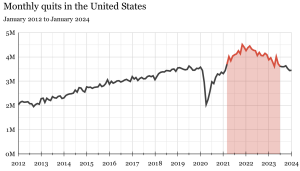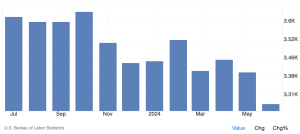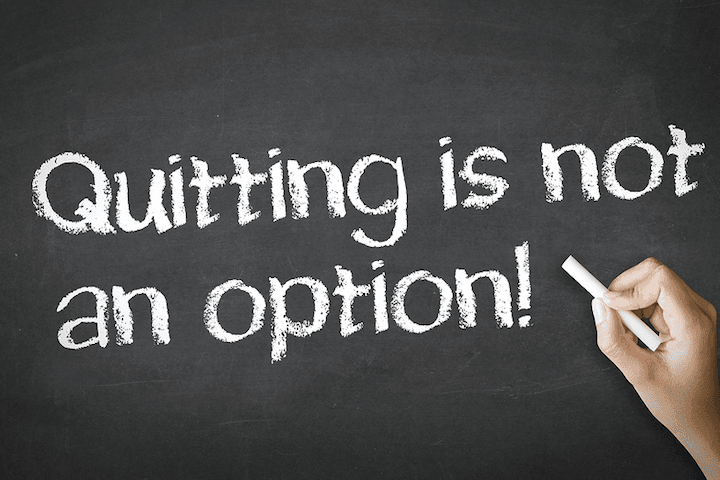Talk to most HR professionals, and it’s retention that is nearly always their top concern.
Well… as the saying goes, be careful what you wish for.
Because in recent months, quit rates in the US have plummeted to a low 2.2% – and this isn’t always the good news we might think it should be (see below):


Churn is a useful (and necessary) thing in the employment market, but not only are people staying, but there has also been a significant drop in job-seeking intentions too – from 49% in the latter half of 2023 to just 35% now.
Employees are clearly opting for stability amid the current social and economic uncertainty – what some commentators are calling ‘The Big Stay.’
But while this shift might seem like a breath of fresh air for companies plagued by high turnover rates and skills shortages, the decrease in the number of employees leaving their jobs should not be a green light for complacency – particularly around maintaining levels of engagement.
The Big Stay’s impact on engagement
Disengaged employees would typically leave organizations, and take their disengagement elsewhere.
Employees that are staying (not because they may want to, but because it feels safer than quitting) present new engagement problems.
Already Gallup’s 2024 State of the Global Workforce report reveals that 67% of employees in North America are disengaged at work.
This disconnect highlights a pressing concern for employers: Lower turnover does not necessarily equate to higher productivity or job satisfaction.
How to handle ‘staying’ employees
Difficult though it might appear, there is a unique opportunity for HR professionals to leverage this period of reduced turnover to enhance employee engagement.
By addressing the underlying issues of employee disengagement and fostering a more dynamic and supportive work environment, organizations can better position themselves for future challenges and ensure their talent strategies remain robust and resilient.
Investing in employee development: A path to enhanced performance and retention
Prioritizing employee development is not just a trend but an imperative strategy for companies aiming to enhance both individual and organizational performance.
When organizations prioritize training and growth opportunities, they do more than just improve employees’ skills; they significantly boost job satisfaction, engagement and productivity while also reducing turnover.
However, for company leaders to effectively drive this strategy, they must remain attuned to the ever-evolving dynamics of the workforce and the changing needs of employees.
According to a recent survey, nearly two in five organizations admit to struggling with identifying and nurturing employees who have leadership potential.
This gap in talent management and skills assessment can undermine efforts to foster a high-performing workforce and hinder long-term organizational success.
To fully benefit from investing in career development, organizations need to regularly reassess and refine their career growth measures.
Promoting a culture of continuous development ensures that companies are meeting the current needs of their employees and preparing them for future challenges.
This proactive approach helps create a more engaged and motivated workforce, ultimately contributing to the organization’s long-term success and resilience.
Focus on the compensation & benefits that employees actually care about
In today’s modern workplace, offering a robust compensation package and attractive benefits is more important than ever for ensuring job satisfaction and employee engagement.
ADP data reveals the median year-over-year pay increase for employees who switched jobs was 10% in March 2024, the highest rate of growth since July 2023.
Meanwhile, during this time period, employees who stayed at their current jobs only saw an annual wage gain of 5.1%. This shows that most employers’ compensation structures are not keeping up with the current job market.
A well-rounded compensation strategy is vital for keeping employees motivated and committed to their roles.
With the labor market experiencing a slowdown, companies now have a unique opportunity to reassess and benchmark their compensation packages.
This is a critical moment for organizations to ensure their employees feel valued and adequately rewarded.
Competitive salaries, performance bonuses and comprehensive benefits packages are key elements that contribute to employees feeling appreciated for their contributions.
These financial incentives play a significant role in maintaining employee morale and engagement.
However, compensation extends beyond just salary and bonuses.
Employees are increasingly prioritizing benefits that enhance their overall wellbeing and work-life balance.
Flexible work arrangements, wellness programs and other non-traditional perks are now critical elements in job satisfaction.
These benefits address employees’ growing focus on maintaining a healthy balance between their personal and professional lives, making the current job more attractive compared to potential opportunities that may offer similar pay, but lack in additional benefits.
By focusing on these areas, companies can create a work environment where staying employees do feel genuinely supported and valued.
The role of data in creating effective workforce strategies
Leveraging data is an imperative strategy for employers who want to understand and effectively engage their workforce.
Advanced analytics platforms provide valuable insights into various aspects of the workforce such as employee motivations, preferences and performance trends.
By harnessing these data-driven insights, companies can develop and implement personalized strategies that are designed to enhance employee engagement and drive productivity.
People analytics have emerged as a transformative tool for leaders aiming to identify key workforce issues and make data-driven decisions.
In fact, a recent survey revealed 74% of company leaders that used people data often to inform their business decisions experienced an improvement in employee engagement, compared to 61% of those from organizations that only occasionally use people data to guide their business decisions.
Leveraging people analytics allows organizations to move beyond assumptions and base their strategies on concrete data.
This approach not only enhances understanding of employee dynamics but also informs more strategic decision-making, leading to improved organizational outcomes.
But to have a proper data strategy, HR teams need more than just advanced analytics tools.
They also need strong rules for managing data, a central system for collecting data and for the full HR team to have buy-in on a data-first strategy.
It’s also important to have at least one person in the HR team who is an expert at analyzing data.
Our research shows that companies that have at least one HR team member in a dedicated data analyst role have happier employees and fewer people leaving their jobs.
Even as hiring slows due to uncertain economic conditions, investing in a comprehensive data strategy for people analytics is a wise move.
By building a strong foundation in data governance and analytics, companies can future-proof their employee engagement strategies and position themselves for success as economic conditions shift.
This forward-looking approach ensures that organizations are prepared to adapt and thrive, regardless of the broader economic landscape.
How leadership can best navigate ‘The Big Stay’
In navigating ‘The Big Stay,’ proactive leadership is crucial for fostering a work environment where employee engagement and growth can flourish.
By staying attuned to the needs of their teams, leaders can create opportunities for skill enhancement and career advancement, which strengthens employee commitment.
Effective leadership provides direction and fosters resilience, ensuring that teams remain focused and motivated during uncertain times.
HR and company leaders must ensure they provide a clear vision, make strategic decisions and adapt to evolving circumstances, all while supporting their team’s overall growth and development.
Ultimately, the role of leadership extends beyond mere management; it involves inspiring and guiding employees through periods of uncertainty.
By prioritizing employee engagement, company leaders can pave the way for continued success even as the economic and job market landscape changes.
